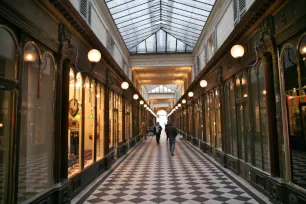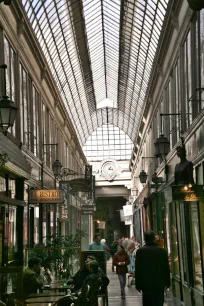Paris’s historic covered arcades – locally known as passages or galeries – were the precursors of today’s shopping malls. Of the more than one hundred passages that were built during the nineteenth century, about twenty have survived.
History



At the end of the eighteenth and beginning of the nineteenth century, numerous covered passages were created in Paris. The passages, mostly shopping arcades covered with glass roofs, were modern symbols of urban life and the place to shop in Paris. Many of these passages were beautifully decorated with mosaic floors, cast iron gates, marble pillars and ornate clocks.
At its peak during the mid-nineteenth century, there was a network of more than 140 passages, many connected to each other. The pedestrianized passages, home to shops, restaurants and apartments, were very popular as they protected visitors from inclement weather and the often dirty and odorous streets. Their popularity soon started to decline due to competition from large department stores such as Galeries Lafayette and Printemps, and many were abandoned and started to fall in disrepair. Others were demolished during the redevelopment of Paris by baron Haussmann between 1852 and 1870.
At the end of the twentieth century, especially during the 1980s, the glass covered passages started a revival, and many of the about twenty surviving shopping arcades were restored, such as the passage Jouffroy with its barrel vault skylight and the elegant Galerie Vivienne with its mosaic floors.
The passages today
Today the passages are home to numerous upscale, quirky and specialty shops. Some, such as the passage Brady and the passage des panoramas, house plenty of restaurants. Rainy days are ideal for a stroll through some of these historic arcades, where you can enjoy the architecture or browse the many boutiques and antique shops while being sheltered from the rain.
Some Highlights


The oldest surviving covered shopping arcade is the Passage du Caire (Cairo Passage). It was built in 1798-1799, at a time when Napoleon held a military campaign in Egypt, hence its name. The second oldest and the first to be equipped with gaslights is the Passage des Panoramas, which opened in 1800.
It was named after panoramic paintings depicting large cities that originally decorated the entrance.
Across the boulevard Montmartre from the Passage des Panoramas are the Passage Jouffroy and Passage Verdeau, both covered with magnificent glass canopies.
Even more spectacular is the glass dome of the Galerie Colbert, one of the most ornate of the arcades in Paris. The adjoining Galerie Vivienne is decorated with mosaic tiled floors, brass lamps and a beautifully renovated clock. It is one of the most upscale arcades, home to several galleries and pricey boutiques.
Other noteworthy passages include the Passage des Princes, Passage Choiseul, Arcade des Champs-Élysées, Galerie Véro-Dodat and Passage du Grand-Cerf, with harmonious wooden shopfronts.
If you’re into Indian and Pakistani food, then a visit to the Passage Brady is in order.



Location
The most interesting covered passages are located in and around the 2nd arrondissement:
- 1e arrondissement:
- Galerie du Palais Royal (2 Place Colette)
- Galerie Véro-Dodat (19 rue Jean-Jacques Rousseau and 2 rue du Bouloi)
- 2e arrondissement:
- Galerie Colbert (4 rue Vivienne and 6 rue des Petits-Champs)
- Galerie Vivienne (6 rue Vivienne and 4 rue des Petits-Champs)
- Passage du Bourg-l’Abbé (120 rue Saint-Denis and 3 rue Palestro)
- Passage du Caire (237-239, rue Saint-Denis)
- Passage Choiseul (40 rue des Petits-Champs and 23 rue Saint-Augustin)
- Passage du Grand-Cerf (145 rue Saint-Denis and 10 rue Dussoubs)
- Passage des Panoramas (11 boulevard Montmartre and 10, rue Saint-Marc)
- Passage du Ponceau (119 boulevard de Sébastopol and 212 rue Saint-Denis)
- Passage des Princes (5 boulevard des Italiens and 97 rue de Richelieu)
- 8e arrondissement:
- Arcade des Champs-Elysées (Arcade du Lido) (76-78 Avenue des Champs-Élysées and 59 rue de Ponthieu)
- Galerie de la Madeleine (9 place de la Madeleine and 30 rue Boissy-d’Anglas)
- 9e arrondissement:
- Passage Jouffroy (10-12 boulevard Montmartre and 9 rue de la Grange-Batelière)
- Passage Verdeau (6 rue de la Grange-Batelière and 31 bis rue du Faubourg-Montmartre)
- 10e arrondissement:
- Passage Brady (46 rue du Faubourg Saint-Denis and 22 boulevard de Strasbourg)
- Passage du Prado (16 boulevard Saint-Denis and 16 rue du Faubourg Saint-Denis)

